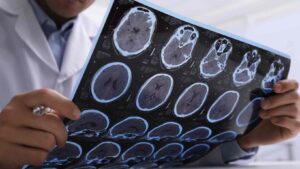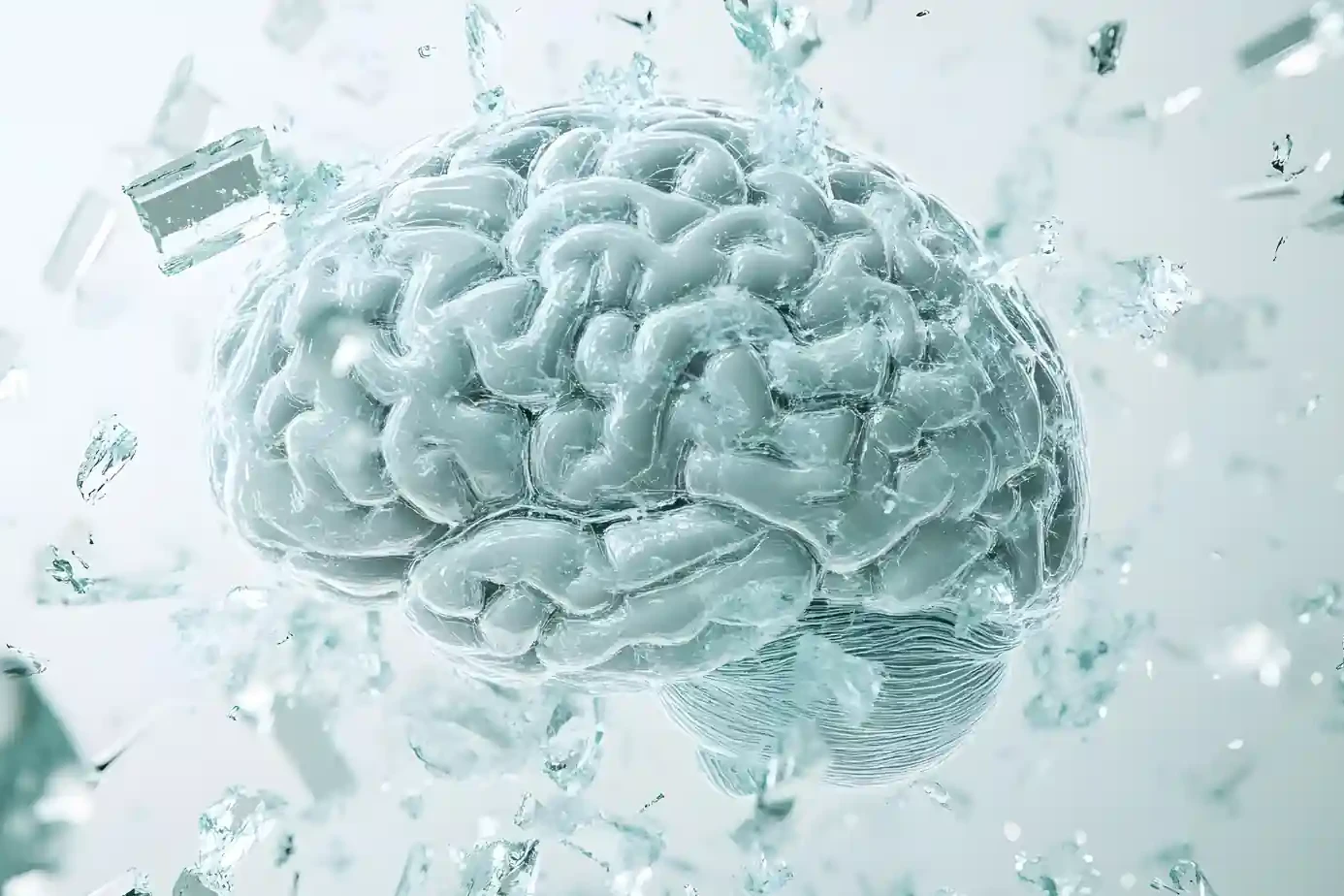Have you or someone you love experienced strange, persistent pain after a stroke? A deep, burning pain that doesn’t go away, and doctors can’t find anything physically wrong?
If so, it might not be “just in your head.” It could be thalamic pain syndrome. This condition is more common than most people think, and it’s often misunderstood.
In this blog, we will explain what thalamic pain syndrome is, why it happens, what the symptoms look like, and how you or your loved one can manage it with expert help from trusted neurologists like Dr. Chandril Chugh.
Let’s break it down.
Table of Contents
ToggleWhat is Thalamic Pain Syndrome?
Thalamic Pain Syndrome , also known as Dejerine-Roussy syndrome or central post-stroke pain , is a neurological condition where damage to the thalamus (a deep part of the brain) causes long-term pain, often on one side of the body.
Your brain has a small structure called the thalamus. It acts like a switchboard—it receives and sends signals between different parts of the brain and body.
When this part of the brain is damaged, it can create wrong signals about pain. This leads to thalamic pain syndrome, a special type of central post-stroke pain (CPSP). The pain is real, but it’s caused by faulty brain signals—not by injury to your skin or bones.
People feel pain, tingling, or burning, even without touching anything hot or sharp. This type of pain usually affects the side of the body opposite to where the brain was damaged.
Why is it Called “Dejerine-Roussy Syndrome”?
Back in 1906, two doctors, Joseph Dejerine and Gustave Roussy, described this strange pain in stroke patients. That’s why thalamic pain syndrome is sometimes called Dejerine-Roussy syndrome.
It’s different from other post-stroke pain syndromes because it involves the brain’s pain-processing center itself, not muscles or joints.
What Causes Thalamic Pain Syndrome?
This condition doesn’t just happen out of nowhere. It often begins after damage to the thalamus.
Stroke and Thalamic Damage
Most cases happen due to a thalamic stroke. There are two main types:
Ischemic stroke: A blood clot blocks a vessel.
Hemorrhagic stroke: A vessel bursts, causing bleeding.
If the posterolateral thalamus is damaged, it’s more likely to cause thalamic pain syndrome.
Did you know? About 8% of stroke survivors develop this condition. That’s nearly 1 out of every 12 people who’ve had a stroke.
Other Rare Causes
While stroke is the main reason, other brain injuries can lead to thalamic pain syndrome too:
Head trauma or brain injury
Brain tumors pressing on the thalamus
Brain surgery complications
These causes are much rarer, but they still damage how the brain handles pain.
Symptoms to Watch Out For
Thalamic pain syndrome can vary, but certain signs are common in most people.
Common Symptoms
After the brain injury, symptoms often start slowly and then worsen.
Chronic pain from brain injury, even when the body part looks fine
Burning pain in limbs after stroke, usually on one side
Hypersensitivity to light touch or mild temperature change
Emotional issues like anxiety, frustration, or sadness
One man described the feeling as “boiling water running under my skin.” That’s how intense it can get.
When Do Symptoms Start?
Interestingly, thalamic lesion pain doesn’t start right away after the stroke or injury. It may take weeks or even months to appear.
In some patients:
Pain begins 1–3 months after the stroke
Pain intensity slowly increases over time
There are good days and bad days
How Is It Diagnosed?

Diagnosis isn’t always straightforward. Symptoms may develop long after a stroke, which makes the connection easy to miss.
A neurologist will look into:
- Stroke history
- Detailed symptom description
- Neurological examination (checking sensation, reflexes, strength)
- Imaging studies such as MRI or CT scan to identify lesions in the thalamus
It’s a clinical diagnosis, often made after ruling out other causes of chronic pain.
To support the diagnosis, doctors may use tests like:
| Test | Purpose |
|---|---|
| MRI/CT Scan | To find thalamic damage or lesions |
| Functional imaging | Optional test to see active pain areas |
| Pain questionnaires | Helps track pain severity and changes |
These tools give a full picture of what’s happening in the brain.
How Thalamic Pain Affects Quality of Life
This isn’t just physical pain, it can affect how someone thinks, feels, and lives.
Emotional and Psychological Impact
Living with neuropathic pain after stroke is exhausting. It can cause:
Depression due to constant discomfort
Trouble sleeping at night (insomnia)
Less interest in social activities
Brain changes from neuroplasticity and pain perception
It becomes a full-body issue, not just a brain issue.
Treatment Options for Thalamic Pain Syndrome
Unfortunately, there is no one-size-fits-all treatment and no guaranteed cure. However, there are several ways to manage symptoms and improve quality of life.
Medications
Doctors usually start with brain-targeting medicines:
| Medicine Type | Examples | Purpose |
|---|---|---|
| Antidepressants | Amitriptyline, Duloxetine | Block brain pain signals |
| Anticonvulsants | Gabapentin, Pregabalin | Calm nerve activity |
| Opioids | Not preferred, used only under close supervision | Often ineffective for brain-origin pain |
Non-Drug Therapies
Medicines don’t always fix the problem. These therapies help too:
Physical therapy: Light stretching and movement
Cognitive behavioral therapy (CBT): Teaches how to handle pain mentally
TENS and biofeedback: Machines that stimulate nerves to ease pain
Combining these with medicines can give better results.
Advanced Treatments
If nothing else helps, these are used for tough cases:
Deep brain stimulation (DBS): Electrodes placed in the brain to block pain
Repetitive transcranial magnetic stimulation (rTMS): Uses magnets to calm pain areas
Spinal cord stimulation
- Surgical lesioning (rare cases): When pain is severe and unresponsive to other treatments
These are safe when done by trained experts.
Living with Thalamic Pain Syndrome
The pain isn’t just physical it takes a toll on emotional health, too. Patients often feel misunderstood or isolated, especially when their pain doesn’t “look” obvious to others.
Coping Strategies:
- Gentle movement : Yoga, swimming, or walking can help reduce discomfort
- Mindfulness and breathing techniques : Reduce stress and improve resilience
- Support groups or therapy : Sharing experiences with others can be a powerful source of relief
Thalamic pain is real. Just because it stems from the brain doesn’t make it “in your head.”
Can Thalamic Pain Syndrome Be Prevented?
We can’t always stop the pain. But we can stop the strokes that cause it.
Stroke Prevention = Primary Prevention
Simple steps to lower stroke risks:
Control blood pressure, cholesterol, and sugar
Eat low-salt, low-fat food
Exercise 30 minutes daily
Avoid smoking and alcohol
Take action on mini-strokes (TIAs)
Early treatment prevents big strokes and stroke recovery and chronic pain later and lowers the risk of complications like thalamic pain syndrome.
Expert Advice From Dr. Chandril Chugh
Thalamic pain syndrome is real. It hurts physically and mentally. But the good news? It can be managed.
If you or someone you love is facing strange pain after a stroke, don’t ignore it. Get help from a neurologist. Book a consultation with me, Dr. Chandril Chugh, and let’s create a plan together.
No one should suffer in silence. Relief is possible. Because every person deserves to live a life free of unnecessary pain, even after a stroke.
FAQs
What does thalamic pain feel like?
Thalamic pain feels like a constant burning, tingling, or stabbing sensation, usually on one side of the body. It may feel like your skin is on fire or being pricked by needles. Even light touch or mild temperature changes can cause severe discomfort. This pain comes from the brain—not from skin or muscles. It often appears weeks or months after a stroke.
Is thalamic pain syndrome permanent?
Thalamic pain syndrome can be long-lasting, but it is not always permanent. Some people improve with medications, therapy, and time. However, for others, symptoms may persist for years. The intensity can fluctuate, with periods of relief and flare-ups. Early treatment can reduce severity and improve quality of life.
What part of the brain is damaged in thalamic pain syndrome?
Thalamic pain syndrome is caused by damage to the thalamus, a deep structure in the brain. The thalamus processes sensory signals like touch, temperature, and pain. Injury here—often from a stroke—leads to misfiring pain signals. Most commonly, the posterolateral thalamus is affected. This results in pain on the side of the body opposite the damage.
Can physical therapy help with thalamic pain?
Yes, physical therapy can help manage thalamic pain by improving movement and reducing sensitivity. While it doesn’t cure the pain, it can lessen discomfort and prevent stiffness or weakness. Therapies may include stretching, balance exercises, and desensitization techniques. Consistent practice supports brain rewiring and functional recovery. It works best when combined with medical treatment.
How common is thalamic pain syndrome after a stroke?
Thalamic pain syndrome occurs in about 8% of stroke survivors. It is more common after strokes that directly affect the thalamus. Not everyone develops it, and symptoms may appear weeks or months after the stroke. It’s considered a type of central post-stroke pain (CPSP). Early detection can lead to better symptom control.
What is the best treatment for thalamic pain?
There is no single “best” treatment, but a combination works best. Doctors often start with antidepressants (like amitriptyline) or anticonvulsants (like gabapentin). Non-drug therapies like CBT, TENS, or physical therapy also help. In resistant cases, advanced options like rTMS or deep brain stimulation are used. Treatment is tailored to each patient’s needs.
Can thalamic pain syndrome be misdiagnosed?
Yes, thalamic pain syndrome is often misdiagnosed, especially early on. Its symptoms can mimic nerve injuries, fibromyalgia, or arthritis. Because the pain appears later after a stroke, it’s sometimes mistaken for unrelated conditions. A detailed neurological exam and brain imaging are crucial for diagnosis. Consulting a neurologist improves accuracy and care.
About The Author

This article is medically reviewed by Dr. Chandril Chugh, Board-Certified Neurologist, providing expert insights and reliable health information.
Dr. Chandril Chugh is a U.S.-trained neurologist with over a decade of experience. Known for his compassionate care, he specializes in treating neurological conditions such as migraines, epilepsy, and Parkinson’s disease. Dr. Chugh is highly regarded for his patient-centered approach and dedication to providing personalized care.
→ Book a consultation to discover which remedies suit your needs best.




